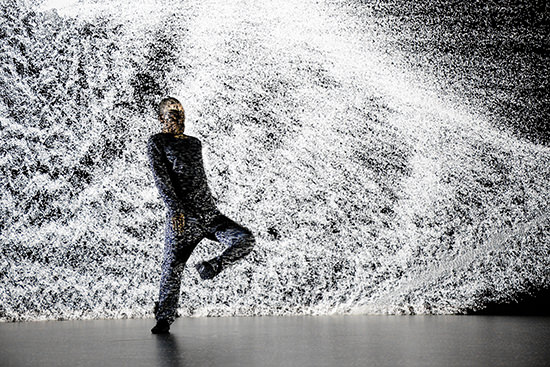OzAsia 2016: a necessary festival
Keith Gallasch: Interview Joseph Mitchell, Artistic Director, OzAsia
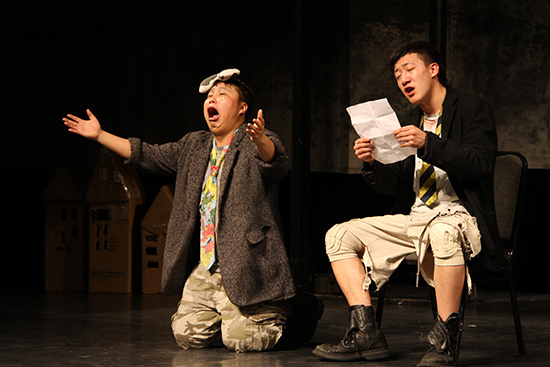
Two Dogs
The program for the 2016 OzAsia Festival reveals director Joseph Mitchell to be in an even more adventurous and expansive mood than for his groundbreaking first in 2015. Contemporary performance, theatre and dance are again central, digital screen art is deservedly prominent and freely accessible live music gets a major boost. Political alertness is evident in a number of performance works and exhibitions and there are intriguing cross-cultural collaborations that bring together Asian and Australian artists. OzAsia 2016 is deeply enticing.
Joseph Mitchell’s engaging smile confirms a joyful sense of purpose. He’s emphatic: he has not programmed OzAsia to display what’s new from Asia. His passion is for the best of contemporary practices, wherever they take place. His vision is about “a fertile belt of creativity in Asia at this point in time.” It might be inspired by innovative Western performance of the 20th century “but also draws on different cultures that have hundreds or thousands of years of history as well as new rules that are being written in places like China, Japan and Korea. The responsibility for an arts festival director is to think about where the arts are going. Personally, much of what is coming out of Asia keeps me interested and excited and always feeling like I’m seeing something new. That’s the thinking behind OzAsia rather than ‘Asia’ as such.”
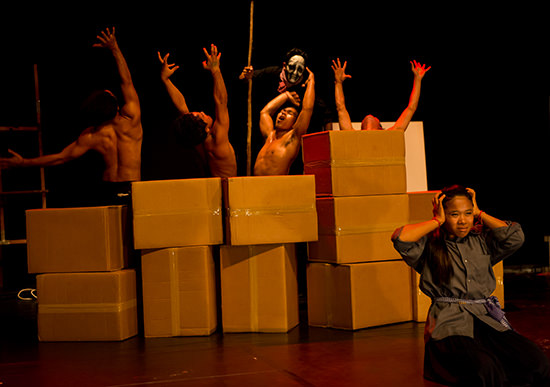
Phare Circus
PHARE CIRCUS (CAMBODIA)
From Cambodia, you’ve programmed a circus, superficially Western in appearance but transformed by the culture that’s adopted it.
There are a couple of things that interest me about Phare Circus. First is the founding principle of the organisation to use art as a means to provide opportunities for young people in a Cambodia that had been decimated by the Khmer Rouge and to embed the value of art, ensuring that another generation doesn’t suffer the same problems. Secondly, these artists are rough and ready. They come from broken, poverty-stricken families and they’ve walked into a school and really given themselves over to education in the arts as a lifestyle choice. You see that in this edge-of-your-seat theatre. It’s not just a series of circus tricks; the company uses circus as a medium to tell important stories about Cambodian culture and particularly what happened under the Khmer Rouge. This 60-minute performance has narratives that draw on the individual experiences of the performers or those of their families or villages but told with minimal text. It brings a lot of gravitas to the circus form.
DIGITAL ART (JAPAN, HONG KONG)
Asian artists have contributed significantly to contemporary culture in the realm of digital media. From Japan you have Hiroaki Umeda and teamLab and from Hong Kong Kingsley Ng. How important is this strand of the festival?
I’ve heard this century referred to as “the Asian century” and “the digital century.” Multimedia has been around in the performing arts since Piscator and Brecht but there’s a sense that in this century there’s a deeper level of immersion in ideas around the body in performance, space and technology. I don’t take lightly decisions on works that are highly visual. There has to be some fundamental artistic dialogue with the technology in really interesting ways.
Umeda didn’t create a choreographic style and then project digital material onto it. He created a 360-degree visual environment with sound broken down to a very basic level. He then put his body in as blank canvas. Those elements are integrated without one preferred over another. He’s created a choreographic language which is unlike any other around the world. I think it takes really bold and innovative artist who can work in their own way to find a language as opposed to being bound by a traditional dance ensemble. Umeda works outside of that system and is breaking ground and that’s no different from Ryoji Ikeda or teamLab or Kingsely Ng.
Split Flow Holistic Strata
You have two works by Umeda in the program—Split Flow and Holistic Strata. He’s also involved with another Japanese choreographer in the program, Mikuni Yanaihara in a work titled Sequential Movement. What’s that work about?
I became aware that Hiroaki had started to create visual art installations in response to his choreographic pieces. I had also been looking at the work of Mikuni Yanaihara, a very influential choreographer and director in Japan and, weirdly enough, stumbled across the fact that she was doing the same sort of thing—digital video artworks created from the perspective of choreography. So we asked them very politely—because they don’t know each other or work together—how they’d feel if we curated some of their digital artworks in the same gallery space. We came up with the title Sequential Movement as an umbrella term to showcase the selection of works by those two artists.
One installation is almost like a 360-degree set; almost like being in a Umeda world. It’s called Holistic Strata, taking the dance work [which is one of the artist’s live performances in the festival] and, rather than you watching it, you’re inside it. There’s another work which involves you as a participant with your eyes closed and Umeda playing with the way light can work across you.
Participation and immersion are spiking now in many different ways. Tell me about your inclusion of teamLab who are well-known for creating immersive spaces.
It’s our 10th anniversary this year and I thought, let’s get some of the big contemporary artists who are making waves around the world. It turned out that Nick Mitzevitch, Director of the Art Gallery of SA, also really likes teamLab as does Erica Green, Director of Adelaide’s Samstag Museum. No-one can do teamLab on their own without many years’ lead-in. So the AGSA were in the process of acquiring a new teamLab work, we picked up another on loan and Erica secured a work via another exhibition. So we’re able to collaborate to present teamLab in Adelaide.
All teamLab works are ever-evolving so that no person will ever see one in the same way. Now, the variation that happens in the five minutes between when I see it and when you see it may not be drastically different but from a philosophical idea around what [constitutes] visual art, teamLab’s perspective is very much about it being a personal experience and everyone interpreting things in a different way and beyond that, everything is evolving and moving anyway. So this adds an extra dimension to the way we subjectively interpret visual art and in this case, a digital art experience. There’s a nice dialogue to enter when you explore these three works.
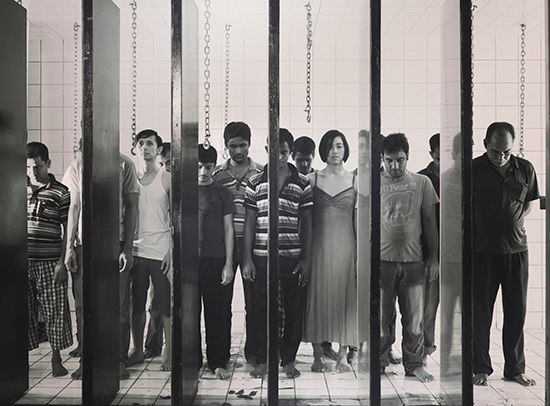
SK!N
TERRYANDTHECRUZ, SK!N (MALAYSIA)
Cross-cultural collaborations also figure in your program, in Bunny (read the RealTime review), a participatory work about bondage by Luke George (Australia) and Daniel Kok (Singapore) and in SK!N by Malaysia’s TerryandTheCuz with Australian artists Ashley Dyer and Govin Ruben. What attracted you to this latter work?
Ashley Dyer is an exciting choreographer and Govin Ruben is a successful lighting designer. They shifted into performance-making, drawing on choreography and production experience to create their own worlds. And they do it so well. I saw this work in development last year and came on board as co-commissioner to help them realise it. They’ll premiere the work in August in Kuala Lumpur and then come straight to OzAsia and then, hopefully, they’ll tour.
How did they make the connection with their Malaysian collaborators?
TerryandTheCuz is based in Kuala Lumpur, as is Govin, and Ashley comes in and out as a close collaborator. They’re a pretty tight-knit group.
The work is about people smuggling and trafficking; tough themes.
The thing about topical and political ideas in the arts [is] you’re generally preaching to the converted; you’re not going to change anyone’s views about migration. But what interests me about this work is more that the artists are putting us through a directly physical experience, using shipping containers. On arrival the audience will be asked to hand over their phones and valuables, be put into holding pens and then have completely different experiences—be given a drink, sung to, blind-folded or find themselves abandoned. I just don’t know how they are going to respond—and that’s a good thing.
.jpg)
Rianto, Softmachine
RIANTO, SOFTMACHINE (INDONESIA)
There are other challenges and border crossings to be found in OzAsia, as in the work of Indonesian dance artist Rianto.
He’s a stunning artist; a real internationalist. He’s a traditionally trained dancer from Central Java but has branched out to write his own rules around what constitutes dance. He draws on the classical, erotic, cross-gender Lengger dance form and has travelled around the world exploring different types of contemporary dance and working with exciting and boundary-pushing, non-conventional choreographers like Singapore’s Choy Ka Fai. He is now creating work that’s unlike anything else. Softmachine is very interesting; I wouldn’t necessarily say it’s dance or theatre or even verbatim documentary theatre—it’s all of those combined and it’s autobiographical. This one piece with Rianto fits into a larger series of four works by Choy Ka Fei called Softmachine Series, with which he’s mapped contemporary dance in Indonesia, Japan, China and India. It’s a huge visual art installation that demonstrates the depth and breadth of the mapping which is bigger than those four countries. It was exhibited in TPAM (Tokyo Performing Arts Market) in Japan but I’m hoping contemporary art spaces, festivals or galleries will pick it up.
600 HIGHWAYMEN, THE RECORD (US)
The Record, by much-lauded Brooklyn company 600 Highwaymen, is another participatory work—for 45 South Australians. How does it fit within your curatorial brief?
I wanted to ensure that our 10th anniversary is built into the curatorial framework of the festival with a work that reflects both the contemporary performance identity that OzAsia has established and captures the multicultural identity of South Australia right now. Two very highly regarded contemporary performance makers auditioned nearly 200 people from across Adelaide, whittling that number down to 45 people, who essentially make up a record of the society that we live in right now, [covering] multicultural background, age and gender range, occupational experience and postcode. We’ve got schoolchildren, taxi drivers, dentists, doctors, students, construction workers. They’re rehearsed over six weeks to present a contemporary movement piece. It’s a really powerful experience to sit in the audience and watch ‘the society that you live in’ onstage performing an abstract movement piece to a beautiful score. For me it evokes a whole series of emotional responses about Adelaide and our community.
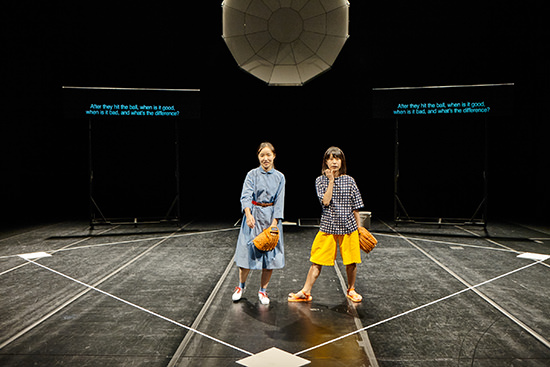
God Bless Baseball
TOSHIKI OKADA, GOD BLESS BASEBALL (JAPAN)
I’m intrigued by God Bless Baseball. I like the idea that a former baseball champion’s onstage performance aligns with Butoh, in the relationship between bat and ball. It seems it’s linguistically interesting as well.
It’s always hard to talk about a favourite in a festival but I have to say that this beautiful, emotionally resonant performance reminds you that theatre doesn’t have to be complex. Here, one of the world’s most prolific contemporary theatre directors, Toshiki Okada, plays to the idea of the perceived and unresolved tension between Korea and Japan while pointing the finger towards the Western influence of America and this strange triumvirate between siblings and parent played out through the metaphor of baseball. That sounds a little heavy-handed but at the same time, it’s weirdly light and dense.
Toshiki Okada wondered if we would understand the work: “Australians don’t know baseball and it’s so particular to Japan and Korea and America.” I said, “No, the metaphor of sport is extremely clear and Australia’s relationship to America post-World War II is not dissimilar. It’s almost like we’re only reflecting on it now, the way America penetrated our countries and so successfully changed our cultures. Australians will completely understand this.”
MENG JINGHUI, TWO DOGS (CHINA)
From mainland China you’ve programmed a two-hander comedy, Two Dogs.
This is our third presentation of work by Meng Jinghui; last year it was Amber. He is the great theatre director in China. Two Dogs is an outright comedy, one of the most performed ‘small theatre’—they call it in China—plays. I think they’ve done over 3,000 performances and the two guys in the lead, Han Pengyi and Liu Xiaoye are real stars. Liu Xiaoye is trained in the Chinese comedy art of ‘cross-talking’— very improvisational, fast-paced, like the Hollywood screwball comedy of the 1930s. Two Dogs really goes to town on many of the challenging aspects of living in contemporary China. It’s about two dogs who leave their home in provincial, rural China and happily trot off to the city to make it big and, of course, they encounter [problems with] the medical system, the penal system, dodgy employment and horrible living arrangements. It really pokes fun at the challenges that everybody in modern China faces.
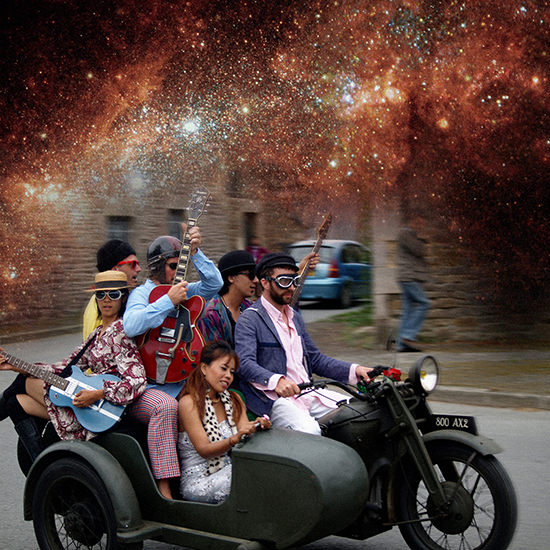
Cosmic Cambodia
OUTDOOR MUSIC CONCERT SERIES
A new dimension of the festival is an outdoor music program, with a great range of idiosyncratic artists and popular music from across the region.
Traditionally we’ve presented community events outdoors, like the Moon Lantern Festival. But I really wanted to bring contemporary culture to the wider audience. So we have 10 nights of free music programming with 23 major international acts. There’s quirky pop rock from Taiwan, underground music from Korea, the fantastic Cosmic Cambodia, the exciting Tenderfist techno duo from Kuala Lumpur and Jabin Law, who’s a big star from Hong Kong. It’s a real mix of very modern musical styles from across the region.
How and where will these concerts be staged?
As part of a huge outdoor environment we’ve called The Good Fortune Market. We’ll take over Elder Park for around 10,000 people to come any night during the festival. There’ll be food stalls and trinket markets, little DJ areas, community stages and roving performances. There’s also a performance tent for Phare Circus and Twelfth Night and other family shows. Right down the bottom of the park we’ll have a big stage for the international acts every night. Someone said, “This is like WOMADelaide,” but I said, “No, this isn’t a world music festival, this isn’t blues and roots, this is contemporary Asia.”
What’s one of the most important dimensions of the festival for you?
Asian performance directors are trying to engage in a deep dialogue with what’s happening in their countries right now—Japan and its tensions with Korea and the influence of the US; Two Dogs cutting into the challenges of living in modern China; and in Company Theatre Mumbai’s Twelfth Night, there’s a real sense of, ‘We were colonised and we’ve taken to Shakespeare, but now we’re gonna completely rip it up, rewrite it in Hindi and tell you our version of the story in a crazy, fast-paced Mumbai way that doesn’t obey the iambic pentameter.’ This is India’s Twelfth Night. Phare Circus is very much about young Cambodian artists re-telling their country’s history through physical performance. SK!N addresses human trafficking which is happening throughout Malaysia and the government doesn’t acknowledge it. Outside our key Indigenous artists, who do it extremely well, are we in Australia making cutting insights into who we are?
MORE HIGHLIGHTS
Also featured in Joseph Mitchell’s program is a retrospective of powerful films by leading Hong Kong filmmaker Johnnie To at the Mercury Cinema. To will also conduct a masterclass. For fans of the great Indian filmmaker Satyajit Ray, there’s a rare screening of Goopy Gayen Bagha Bayen (1959), a fantastical, funny adventure film with music and dancing and quite unlike anything else the master made. The score will be played live on traditional Indian instruments with the Adelaide Symphony Orchestra.
Adelaide’s disability-led Tutti Arts is collaborating with internationally renowned Indonesian artist Andres Busrianto to create an interactive street art installation and, also on the Riverside Precinct, “a secret underground wonderland of temples. Inside each, you’ll discover performance art based around the theme of animals and iconography from South East Asia” (program).
From far western Asia comes Israel’s Vertigo Dance Company and from Hong Kong City Contemporary Dance Company, which combines contemporary Western choreography and Chinese tradition within a multimedia framework.
At the Adelaide Festival Centre, Damien Shen, a Ngarrindjeri man with Chinese bloodlines, and Chinese artist and political cartoonist Badiucao will collaborate on matters of identity and culture.
OzAsia calls
As other international arts festivals swell beyond a sense of community, Adelaide’s OzAsia stands out for its manageable scale, its cultural and regional specificity, its timeliness and its insightful engagement with issues and artforms. It demands our attention. RealTime will be there.
–
OzAsia Festival, Adelaide Festival Centre, 17 Sept-2 Oct
RealTime issue #133 June-July 2016


